The One True Way™ to watch Star Wars is a hotly debated topic in many circles. With the completion of the Skywalker Saga last December and today’s release of the final film to Disney+, there’s no better day to watch the whole saga; so we’re here to walk you through the full watching order, episode by episode, so you can see why this way is the best and know what to look out for.
Please note: this list contains many spoilers, but for the things that the entirety of Western culture already knows anyway.
So why do we need a new watching order anyway? They were released in an eclectic order—4, 5, 6, 1, 2, 3, 7, 8, 9. Most fans would tell you to watch them in that order, as the originals were certainly better films.
But the Flashback Order posits that the prequel trilogy was never intended to be watched first, but was instead an extended flashback. It gives the fist six films a better start and end, maintains more (and better) surprises, creates better tension, increases Yoda’s role, makes Vader’s redemption more believable, and improves Luke’s journey. It even gives the sequel trilogy a stronger base to build from, providing Luke’s actions in The Last Jedi a more solid base in the lore of the story.
The Flashback Order is tested, and it works well. And to understand what it’s trying to do, you just need to know that the whole order hinges on answering one driving question posed at the end of The Empire Strikes Back: Was Darth Vader lying to Luke?
The Lucas Saga
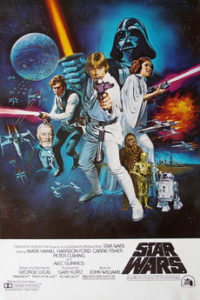
The Beginning Of It All: Episode IV – A New Hope (1977)
We start with the original Star Wars. It’s a natural place to begin, because it’s the beginning. It sets up the universe nicely and provides a very solid stand-alone story. It’s a much better beginning than Episode I, and maintains all of the spoilers (because they weren’t written yet when the film was released). There’s an incredible attention to world building throughout, and it’s a very rewarding way to begin.
Watch for: The Hero’s Journey. Oft-cited as the most compelling example of the Hero’s Journey in film, Lucas himself calls out Campbell’s work in behind-the-scenes interviews, detailing how he used the monomythological pattern for the story of Luke. That story holds its most pure expression here.
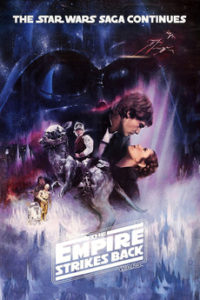
The Big Question: Episode V – The Empire Strikes Back (1980)
Watching this film in the second position preserves its original culture-defining nature in many ways, including maintaining the narrative impact of the most critical twist of cinema history. It also preserves the more minor surprise of Yoda’s true nature. The lesser surprise of Palpatine’s identity, which will be paid off in the prequels, can be retained if you watch the theatrical VHS or DVD versions, or the Despecialized Editions; but it’s a weak, over-telegraphed, incredibly obvious “surprise” that honestly doesn’t need to be preserved.
Placing Empire before the prequels also gives a narrative weight to the tension, drawing it out like it hasn’t been since 1980.
Watch for: Empire asks the biggest question in the franchise: Who is Vader? Is he lying to Luke? With the Flashback Order, we get to see the answer to that question played out over the next three films.
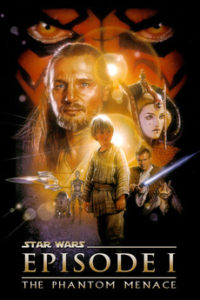
The Flashback Begins: Episode I – The Phantom Menace (1999)
Now we diverge from the release order for an extended “flashback.” As we venture through the prequels, viewers are given the opportunity to wonder- is Vader lying? Watching Episode I in the third position also diminishes the role of Jar Jar Binks and provides some back story where it matters most. We’re only one episode removed from Luke’s boyhood on Tatooine, and seeing Anakin’s here draws some clear parallels.
Watch for: This film drops in some of the best action in the prequel trilogy, amidst all of the political maneuvering and slapstick. The Podrace and the lightsaber duels are truly incredible.
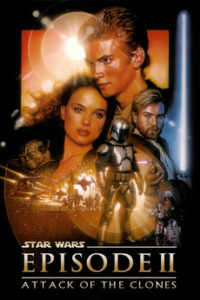
The Descent: Episode II – Attack of the Clones (2002)
The weakest of the Star Wars franchise so far, burying this film in the middle instead of near the beginning or the end weakens the bite of its bad romance dialogue and provides a base that will make both of the following entries from the Lucas-helmed saga shine all the brighter.
Here we do see much of the beginnings of who Vader will become, making its new place more poignant. It’s gone from being a nondescript second film to being a hinge upon which the entire original saga can turn.
Watch for: The shading of who Anakin Skywalker is becoming begins to grow in this episode. Notice even the small places where he’s beginning to look down a path he shouldn’t be.
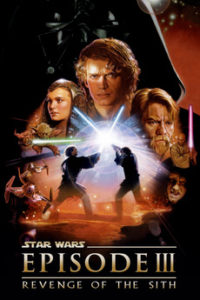
Answers: Episode III – Revenge of the Sith (2005)
The best of the prequel trilogy, it finally answers the question demanded by Vader’s shocking reveal in Empire. It makes Luke’s subsequent acceptance in Jedi seem all the more realistic as a result, and placing Episode III after that big reveal retains the audience’s suspension of disbelief that he didn’t believe him in the first place.
In addition, Luke’s seeming-flirtation with the dark side at the beginning of Jedi is made more threatening and deep by seeing Anakin go through some of those similar threads here.
Watch for: As Lucas begins to wrap up his prequels, he starts weaving in continuity from the Original Trilogy, not as fanservice, but as little bits of world building for the future. A lot of it connects directly to Jedi.
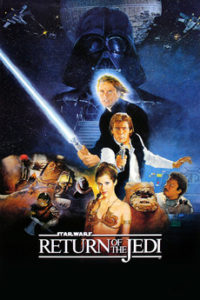
The Final Conflict: Episode VI – Return of the Jedi (1983)
Placing Jedi after the prequel trilogy not only elevates the prequels, it also elevates Jedi itself! Originally the weakest of the original trilogy, so many threads from the prequels resolve here that it feels like a much more dramatic payoff. The finality with which this episode closes out the original story of the Skywalker family feels much more grounded by the prequels’ new positioning, and seeing the rise and fall of Darth Vader essentially compressed into two films rather than separated by four makes it all the more potent.
In addition, the dramatic thread of Vader’s final action in Jedi is more powerful, since we saw him in a similar situation in Palpatine’s chambers during the climax of Sith just a single film earlier during Mace Windu’s final confrontation with Palpatine.
Watch for: The ways in which Luke seems to be following in his father’s dark footsteps. It’s a subtle, easily-missed detail that adds a lot of depth to the storyline.
• • •
This is a natural breakpoint for your marathon; since there’s more than 24 hours of Star Wars content now, you need to stop somewhere to sleep. This is a good place to break; you’ve seen the Lucas-helmed saga, and as you’re about to move into the Disney canon, things are about to change.
The Disney Saga
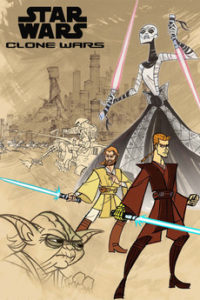
The Wild Card: Clone Wars (2003)
Not to be confused with The Clone Wars, the CGI series with a shockingly similar name that also ends today, this 2D Genndy Tartakovsky delight is feature-length when watched together, and brilliant.
It is perhaps the best piece of Star Wars content written about the prequel era. A short collection of animated works (all only a few minutes long) which bridges the gap between Episode II and Episode III and provides some interesting character development and incredible action for all the characters. While not technically part of the Disney era (and indeed it was decanonized when Disney acquired the franchise), this is a rollicking good time that will comfortably ease you back in to your saga viewing.
Watch for: Chapter 12 and 13 of “Season 2,” wherein Mace Windu wordlessly takes on an enormous mass of battle droids, on his own, without a lightsaber. It’s beautiful both narratively and technically.
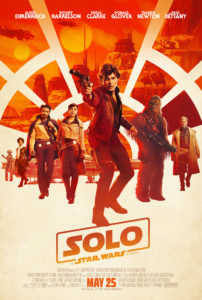
An Antihero’s Origin: Solo: A Star Wars Story (2018)
Another fun, lighthearted romp. While not the best Star Wars film (or even the best prequel), Solo acquits itself quite well; and watching it before Han’s reappearance in the Sequel Trilogy starkly shows you just how far he’s come. It also has a great “feel” to it, nestling quite nicely into the height of Palpatine’s empire.
Watch for: Donald Glover’s film-stealing role as Lando Calrissian. This is the high point of the film for sure.
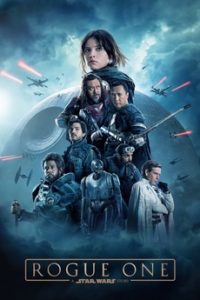
End of an Era: Rogue One: A Star Wars Story (2016)
Our first real foray outside the Skywalker family story, Rogue One is an excellent film that actually transitions between Episode III and Episode IV. However, the dramatic tensions of those particular stories should remain where they are, leaving this film as a bookend that ironically leads us right back into Episode IV. It’s something of an intermission in the storyline, a natural break and decision point from which we could venture back to the beginning or forge forward.
Watch for: All the ways that this film does a prequel story correctly.
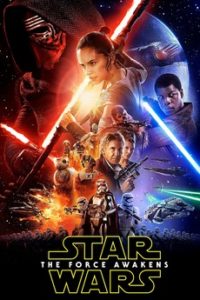
The Next Generation: Episode VII – The Force Awakens (2015)
This film essentially kicks off an entirely new cycle within the Star Wars mythos, but there are enough connective threads to the original trilogy to merit its placement in this list rather than a spot on a new list.
Some would deride The Force Awakens as a clone of A New Hope, but the distinctions and narrative echoes are interesting; in addition, the kickoff for the new generation of films is aided by its strong ties to the past.
Watch for: The places where the echoes of the Original Trilogy are the strongest are also the most important narrative beats. Spot the connections and you can figure out the whole story before it even starts.
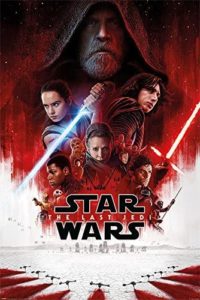
A Line in the Salt: Episode VIII – The Last Jedi (2017)
A divisive film, the one thing everyone can agree upon about The Last Jedi is that it was a different film from what had come before. It took risks and subverted expectations in many new and surprising ways; the controversy comes when you ask people whether that was successful or not. Either way, its placement in the watch order can’t really be anywhere else; it has to build upon Episode VII and prepare for the finale of Episode IX.
Watch for: Luke Skywalker’s defining moment in two trilogies has been tossing a lightsaber away. Notice the different ways it shapes the narrative in The Last Jedi as opposed to Return of the Jedi.
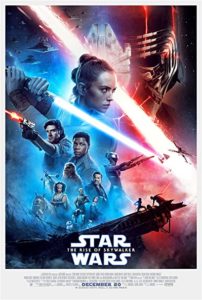
The Final Finale: Episode IX – The Rise of Skywalker (2019)
Your opinion of Episode IX is largely going to be informed by your opinion of the other sequel trilogy entries, but the weight of history lies heavily on The Rise of Skywalker. It caps off the Skywalker Saga as a whole, not just the sequel trilogy; and as such, you have to have seen everything else before you watch this one. But if you have seen it all, it’s a fun ride and brings some unbelievable visuals along with it.
Watch for: Callbacks to every single other film in this series can be found in this one. And while it gets a bit uneven at points, it is a worthy conclusion to the saga.
What about…?
But what about Rebels? Or The Clone Wars? Or Resistance? Or Caravan of Courage? Or The Mandalorian? Well, they’re all worth watching (except Caravan of Courage), but this list is about feature-length experiences. After you finish the Star Wars films, watch the shows in whatever order you like (though may we suggest The Clone Wars, Rebels, The Mandalorian, Resistance), as long as you’re aware that you’re in it for the long haul (and The Mandalorian in particular isn’t even over yet). For other watching orders, check with our Star Wars podcast guys, Home One Radio.
May the Force Be With You
So there you have it. We think this is the best way to watch the saga that essentially defined modern filmmaking; no matter how you watch it, enjoy your foray into that galaxy far, far away.
• • •
An earlier version of this article was originally posted on Redeeming Culture for Star Wars Day 2015, then revised and expanded for Star Wars Day 2017.


